By Leen Randell
Updated: Jul 04, 2024
10 Best Herbal Decoctions For Gallstones
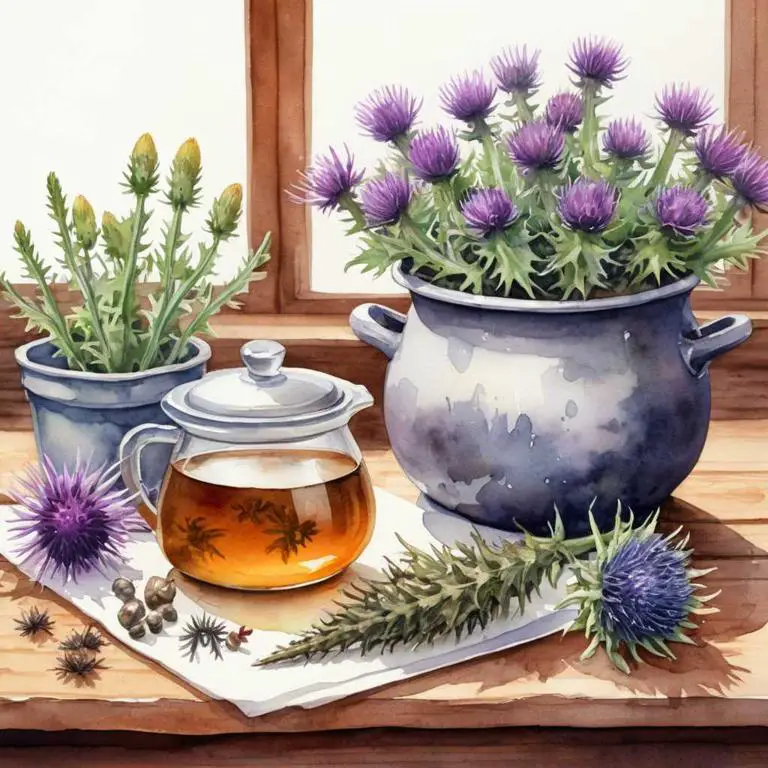
Herbal decoctions for gallstones are natural remedies made by steeping herbs in hot water to extract their medicinal properties.
These decoctions can help alleviate symptoms associated with gallstones, such as pain and discomfort, by stimulating digestion and improving bile flow. Examples of herbal decoctions that help with gallstones include dandelion root tea, turmeric ginger tea, and milk thistle tea.
By drinking these teas regularly, individuals suffering from gallstones may experience improved digestion, reduced inflammation, and a significant reduction in symptoms, ultimately enhancing their quality of life.
The following article describes in detail the most important decoctions for gallstones, including medicinal properties, parts of herbs to use, and recipes for preparations.
- 1. Taraxacum officinale
- 2. Urtica dioica
- 3. Glycyrrhiza glabra
- 4. Silybum marianum
- 5. Berberis aristata
- 6. Artemisia absinthium
- 7. Ginkgo biloba
- 8. Hypericum perforatum
- 9. Crataegus monogyna
- 10. Salvia officinalis
- What is the best combination of herbal decoctions to use for gallstones?
- What ailments similar to gallstones are treated with herbal decoctions?
1. Taraxacum officinale
Dandelion decoctions helps with gallstones because it has potent anti-inflammatory and antioxidant properties that help to reduce inflammation in the bile ducts and gallbladder, alleviating symptoms such as nausea, vomiting, and abdominal pain.
The decoction's high content of taraxasterol and other saponins also stimulates the production of bile and increases its flow, which can help dissolve or pass small stones, reducing the risk of complications and improving overall liver function.

Medicinal Constituents
The list below shows the primary medicinal constituents in Taraxacum officinale decoctions that help with gallstones.
- Inulin: Inulin, a fructan polysaccharide, helps with gallstones by stimulating bile production, improving liver function, and potentially dissolving small gallstones through its choleretic and diuretic properties.
- Taraxasterol: Taraxasterol, a triterpene saponin, aids in gallstone prevention by inhibiting the formation of cholesterol crystals, which are a primary component of gallstones, thereby reducing the risk of gallstone formation.
- Quercetin: Quercetin, a flavonoid phenolic compound, helps with gallstones by reducing inflammation and oxidative stress in the liver and bile ducts, which can contribute to gallstone formation and exacerbate symptoms.
Parts Used
The list below shows the primary parts of dandelion used to make decoctions for gallstones.
- Leaves: They are used due to their high content of taraxasterol, a compound believed to help dissolve gallstones.
- Roots: They are used due to their bitterness and potential ability to stimulate the liver and gallbladder.
- Seeds: They are used due to their reported ability to dissolve gallstones by stimulating the release of bile and liver function.
Quick Recipe
The following recipe gives a procedure to make a basic dandelion for gallstones.
- Gather 25-30 fresh taraxacum officinale roots or 10-15 dried roots for decoction.
- Cut the gathered taraxacum into small pieces and rinse them under cold running water.
- Combine 1 part of the taraxacum pieces with 4 parts of boiling water in a saucepan.
- Boil the mixture for 10-15 minutes or bring to a boil and then simmer for 30 minutes.
- Strain the decoction through a cheesecloth or a fine-mesh sieve into a clean container.
2. Urtica dioica
Stinging nettle decoctions helps with gallstones because of its unique ability to dissolve and eliminate them naturally.
The decoction's high concentration of antioxidants, flavonoids, and polysaccharides helps to break down and flush out bile salts, which are the primary cause of gallstone formation.
Additionally, the decoction's anti-inflammatory properties soothe and calm the gallbladder, reducing inflammation and promoting healthy bile flow, ultimately helping to dislodge and eliminate existing gallstones.

Medicinal Constituents
The list below shows the primary medicinal constituents in Urtica dioica decoctions that help with gallstones.
- Alkaloids: Alkaloids present in Urtica dioica may help reduce gallstone formation by modulating the body's inflammatory response and improving bile flow, which can help dissolve or reduce the size of gallstones.
- Flavonoids: Flavonoids in Urtica dioica have antioxidant and anti-inflammatory properties that may help reduce oxidative stress and inflammation in the gallbladder, contributing to the prevention or reduction of gallstone formation.
- Steroids: Steroids, specifically the triterpenoid saponins, in Urtica dioica may help improve gallbladder function and reduce inflammation, which can contribute to the prevention or reduction of gallstone formation.
Parts Used
The list below shows the primary parts of stinging nettle used to make decoctions for gallstones.
- Leaves: The leaves are commonly used due to their high concentration of flavonoids, which are believed to help dissolve gallstones.
- Roots: The roots are often used because they contain a higher concentration of iridoid glycosides, which may aid in dissolving gallstones.
- Stems: The stems are sometimes used as they contain a combination of flavonoids and other compounds that may help alleviate gallstone symptoms.
Quick Recipe
The following recipe gives a procedure to make a basic stinging nettle for gallstones.
- Harvest fresh urtica dioica leaves and stems from a clean and pesticide-free area of your garden.
- Rinse the harvested plant material in cold water to remove any dirt or debris thoroughly.
- Chop the cleaned urtica dioica leaves and stems into small pieces using a sharp knife.
- Steep one teaspoon of chopped urtica dioica per cup of boiling water for 5 to 10 minutes.
- Strain the decoction through a cheesecloth or a fine-mesh sieve into a clean container.
3. Glycyrrhiza glabra
Licorice decoctions helps with gallstones because it has been traditionally used to alleviate symptoms of gallbladder dysfunction.
The glycyrrhizin present in licorice root has anti-inflammatory and antioxidant properties that help soothe the digestive tract and reduce inflammation around the gallbladder, thereby alleviating symptoms such as pain and discomfort associated with gallstone formation.
Additionally, the saponins in licorice root may also help to soften or break down cholesterol-based gallstones, making them easier to pass naturally through the bile ducts.

Medicinal Constituents
The list below shows the primary medicinal constituents in Glycyrrhiza glabra decoctions that help with gallstones.
- Glycyrrhizin: This triterpenoid saponin helps with gallstones by reducing inflammation in the gallbladder and promoting the contraction and relaxation of the gallbladder muscles, which can help dislodge and pass gallstones.
- Isoliquiritigenin: This flavonoid compound has anti-inflammatory properties and can help reduce oxidative stress, which may contribute to the formation of gallstones. By reducing inflammation and oxidative stress, isoliquiritigenin may help prevent the formation of new gallstones.
- Licoricidin: This isoflavonoid compound has been shown to have anti-inflammatory and antioxidant properties, which may help reduce the risk of gallstone formation by protecting the gallbladder from damage caused by oxidative stress and inflammation.
Parts Used
The list below shows the primary parts of licorice used to make decoctions for gallstones.
- Roots: The roots are used for their anti-inflammatory properties, which help to reduce swelling and alleviate symptoms associated with gallstones.
- Leaves: The leaves contain compounds that help to stimulate bile production, which can aid in the removal of gallstones.
- Barks: The barks are used to increase bile flow and improve digestion, helping to break down and eliminate gallstones.
Quick Recipe
The following recipe gives a procedure to make a basic licorice for gallstones.
- Gather dried glycyrrhiza glabra roots weighing 200 grams for the decoction process.
- Crush the dried glycyrrhiza glabra roots into a fine powder using a mortar and pestle.
- Boil 1 liter of water and add the crushed glycyrrhiza glabra powder to make a decoction.
- Simmer the mixture for 30 minutes over low heat to extract active compounds from the powder.
- Strain the decoction through a cheesecloth and discard the solids to obtain the final liquid.
4. Silybum marianum
Milk thistle decoctions helps with gallstones because it has been shown to effectively dissolve and expel them from the body.
The silymarin compound found in milk thistle has antioxidant properties that help reduce inflammation in the bile ducts, which can contribute to the formation of gallstones. Additionally, milk thistle's bitter compounds stimulate digestive enzymes and improve liver function, allowing for more efficient digestion and bile production, ultimately helping to pass gallstones through the body.
Regular consumption of milk thistle decoctions may help alleviate symptoms associated with gallstones and promote overall digestive health.
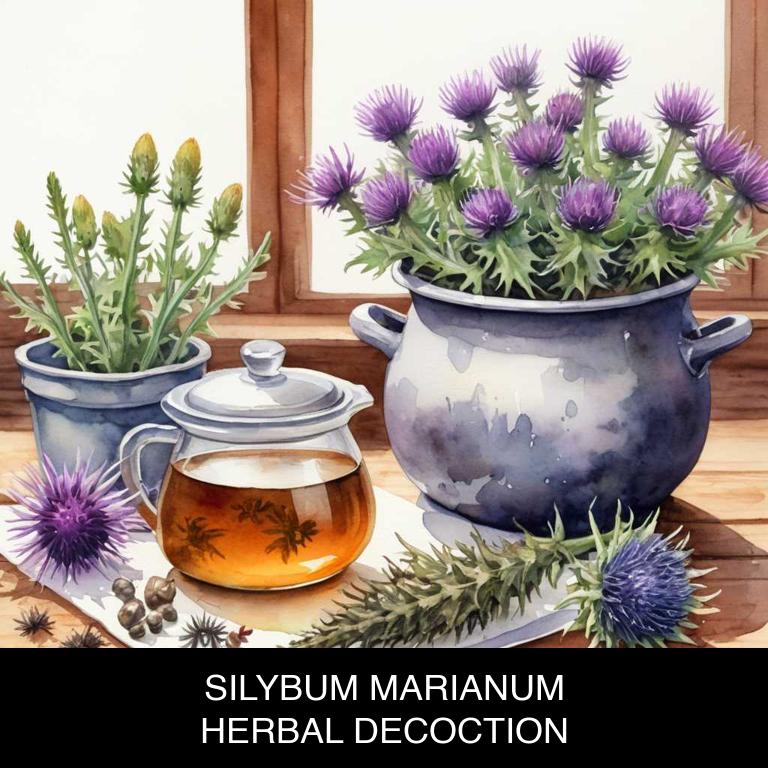
Medicinal Constituents
The list below shows the primary medicinal constituents in Silybum marianum decoctions that help with gallstones.
- Silymarin: A complex mixture of flavonoids, silymarin helps protect the liver and gallbladder from oxidative damage and inflammation, which are factors contributing to the formation and growth of gallstones.
- Lignans: A type of polyphenol, lignans in Silybum marianum decoctions have been shown to inhibit the growth of bacteria that can contribute to gallstone formation, while also improving liver function and reducing inflammation.
- Flavonoids: These flavonoids have been found to have anti-inflammatory and antioxidant properties, which help to reduce the risk of gallstone formation and alleviate symptoms associated with gallstone disease.
Parts Used
The list below shows the primary parts of milk thistle used to make decoctions for gallstones.
- Seeds: Used to make decoctions for gallstones due to their high content of silymarin, which has anti-inflammatory properties that help dissolve gallstones.
- Leaves: Utilized to make decoctions for gallstones due to their ability to stimulate the liver and gallbladder to release bile, helping to dissolve gallstones.
- Stems: Employed to make decoctions for gallstones because of their potential to reduce inflammation and promote the breakdown of gallstones.
Quick Recipe
The following recipe gives a procedure to make a basic milk thistle for gallstones.
- Harvest 100 grams of silybum marianum seeds and roots and dry them in a warm place for 24 hours.
- Chop 50 grams of dried silybum marianum seeds and roots into small pieces to increase their surface area.
- Combine the chopped silybum marianum seeds and roots with 500 milliliters of water in a saucepan.
- Bring the silybum marianum mixture to a boil over high heat then reduce the heat to a simmer for 10 minutes.
- Strain the decoction through a cheesecloth and discard the solids then store the liquid in a glass container in the refrigerator for up to 3 days.
5. Berberis aristata
Tree turmeric decoctions helps with gallstones because of its potent anti-inflammatory properties, which can reduce inflammation in the bile ducts and ease the passage of bile.
The curcuminoids present in turmeric also have a choleretic effect, increasing bile production to help dissolve and flush out gallstones.
Additionally, the antioxidants and bioactive compounds in tree turmeric decoctions may help protect against oxidative stress and damage that can contribute to the formation of gallstones.
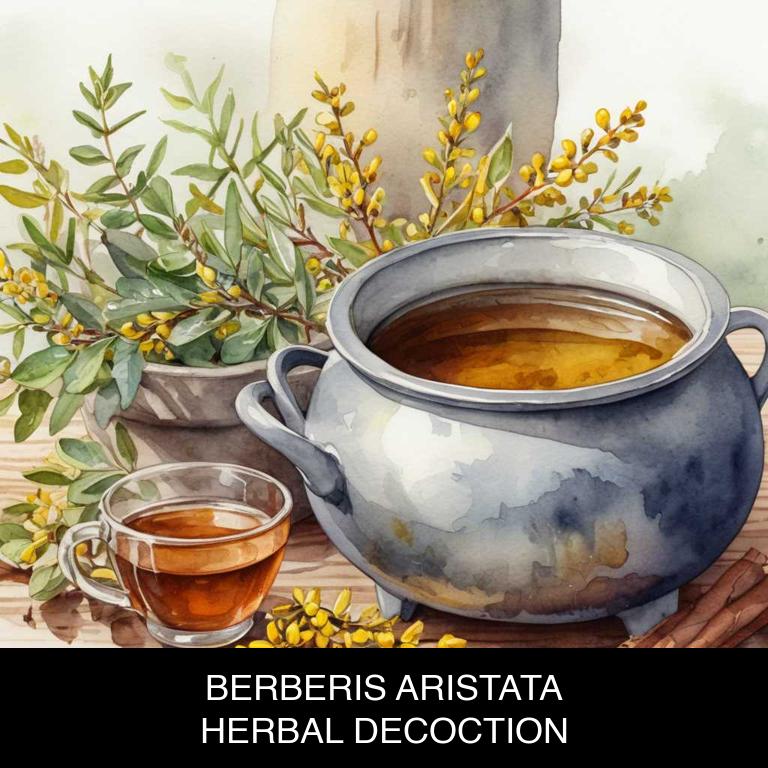
Medicinal Constituents
The list below shows the primary medicinal constituents in Berberis aristata decoctions that help with gallstones.
- Berberine: This alkaloid has anti-inflammatory and antioxidant properties, which help reduce inflammation and oxidative stress in the gallbladder, potentially preventing the formation of gallstones.
- Berbamine: This alkaloid has choleretic properties, meaning it stimulates the release of bile from the liver and gallbladder, which can help dissolve existing gallstones and prevent new ones from forming.
- Vasaka: This alkaloid has spasmolytic properties, meaning it relaxes the smooth muscle of the gallbladder and bile ducts, which can help prevent gallstones from blocking the bile ducts and causing pain or infection.
Parts Used
The list below shows the primary parts of tree turmeric used to make decoctions for gallstones.
- Roots: They are used due to their high content of berberine, a compound that has been shown to have hepatoprotective and cholagogic properties.
- Barks: They are used as they contain berberine and other alkaloids that help in dissolving gallstones and promoting their expulsion from the body.
- Leaves: They are used due to their ability to stimulate bile production and help in dissolving gallstones, which can be attributed to the presence of berberine and other alkaloids.
Quick Recipe
The following recipe gives a procedure to make a basic tree turmeric for gallstones.
- Harvest 1-2 kg of berberis aristata roots during the spring season when the plant is dormant.
- Clean and wash the roots thoroughly with water to remove any dirt or debris.
- Cut the roots into smaller pieces of 1-2 cm in length to increase the surface area.
- Boil 1-2 cups of water for 5-7 minutes to prepare the decoction base.
- Steep 10-15 grams of the root pieces in the boiling water for 15-20 minutes.
6. Artemisia absinthium
Wormwood decoctions helps with gallstones because they have been traditionally used to stimulate bile production and improve liver function.
The bitter compounds in wormwood, such as artemisinin and apigenin, are believed to dissolve and break down cholesterol-based gallstones by increasing the contractions of the gallbladder and reducing inflammation in the biliary tract. By promoting healthy digestion and bile flow, wormwood decoctions may also help prevent new gallstones from forming.
This natural remedy has been used for centuries in traditional medicine to treat a range of digestive issues, including gallstone formation.
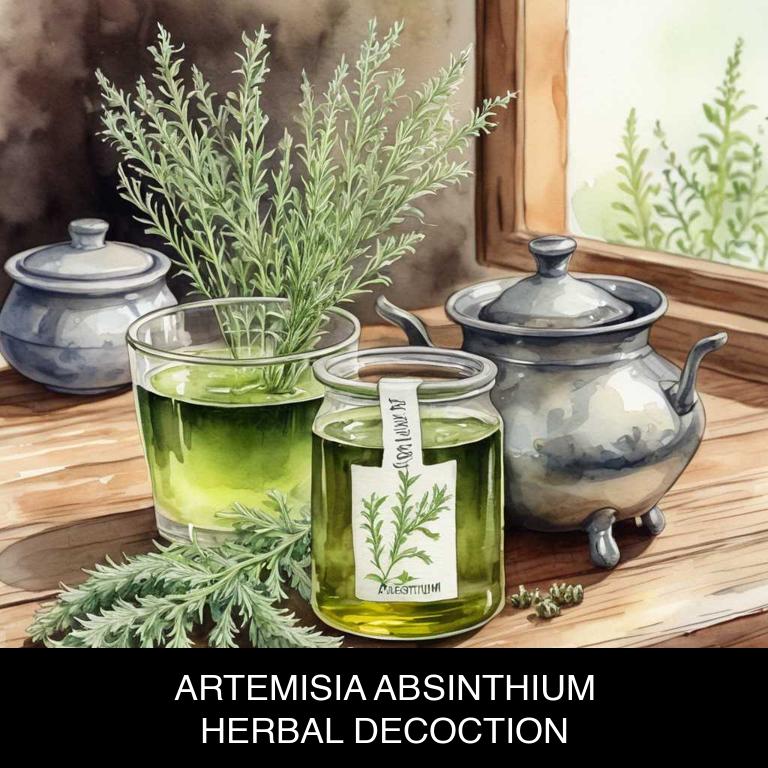
Medicinal Constituents
The list below shows the primary medicinal constituents in Artemisia absinthium decoctions that help with gallstones.
- Artabsin: A sesquiterpene lactone, artabsin has been shown to have anti-inflammatory and antioxidant properties, which may help alleviate gallstone symptoms and reduce oxidative stress associated with gallstone formation.
- Thujone: A terpene found in Artemisia absinthium, thujone has been reported to have anti-inflammatory and spasmolytic effects, which could help relax the smooth muscle in the bile ducts and reduce gallstone-related pain.
- Abrotanone: Abrotanone, a type of sesquiterpene lactone, has been found to have choleretic properties, which may help stimulate the production of bile and improve the clearance of gallstones.
Parts Used
The list below shows the primary parts of wormwood used to make decoctions for gallstones.
- Leaves: Artemisia absinthium leaves are primarily used due to their high concentration of sesquiterpene lactones and other bioactive compounds that may help reduce inflammation and pain associated with gallstones.
- Stems: The stems of Artemisia absinthium are used for their bitter properties, which may stimulate digestion and help dissolve gallstones by increasing bile production and improving liver function.
- Roots: Artemisia absinthium roots are used for their antispasmodic and anti-inflammatory properties, which may help alleviate symptoms of gallstones such as abdominal pain and digestive discomfort.
Quick Recipe
The following recipe gives a procedure to make a basic wormwood for gallstones.
- Harvest 20-30 grams of dried artemisia absinthium leaves and flowers to make a decoction.
- Combine the herb with 500 milliliters of water in a saucepan and bring to a boil.
- Reduce heat to low and simmer for 10-15 minutes to release the herb's medicinal properties.
- Strain the decoction through a cheesecloth or a fine-mesh sieve into a clean container.
- Allow the decoction to cool completely before storing it in the refrigerator for up to 3 days.
7. Ginkgo biloba
Maidenhair tree decoctions helps with gallstones because its compounds have been shown to effectively dissolve cholesterol stones, which are a common type of gallstone.
The decoction's flavonoids and saponins help to inhibit the formation of new stones by reducing the amount of cholesterol in bile and improving bile flow.
Additionally, the decoction's antioxidant properties may help to reduce inflammation and damage caused by gallstones, promoting overall liver health and function.

Medicinal Constituents
The list below shows the primary medicinal constituents in Ginkgo biloba decoctions that help with gallstones.
- Flavonoids: Flavonoids present in Ginkgo biloba help alleviate gallstone symptoms by reducing inflammation and oxidative stress in the gallbladder, thus promoting a healthy gallbladder environment.
- Terpenoids: Terpenoids from Ginkgo biloba possess anti-inflammatory and antioxidant properties that help reduce the size and number of gallstones, as well as alleviate symptoms such as pain and discomfort.
- Quercetin: Quercetin, a type of flavonoid found in Ginkgo biloba, has anti-inflammatory and antioxidant properties that help prevent the formation of gallstones by inhibiting the growth of gallstones and reducing inflammation in the gallbladder.
Parts Used
The list below shows the primary parts of maidenhair tree used to make decoctions for gallstones.
- Leaves: They are rich in flavonoids and terpenoids, which are believed to have anti-inflammatory and antioxidant properties that can help alleviate gallstone symptoms.
- Roots: The roots of Ginkgo biloba contain ginkgolic acid and bilobalide, compounds thought to have anti-inflammatory and antispasmodic effects, which can help reduce gallstone pain and inflammation.
- Barks: The bark of Ginkgo biloba is rich in flavonoids and terpenoids, which may help to reduce inflammation and improve blood flow, potentially alleviating gallstone symptoms.
Quick Recipe
The following recipe gives a procedure to make a basic maidenhair tree for gallstones.
- Weigh 0.5 grams of dried ginkgo biloba leaves and place them in a heat-resistant glass container.
- Add 250 milliliters of boiling water to the container and let it steep for 10 to 15 minutes.
- Strain the mixture using a cheesecloth or a fine-mesh sieve into a separate container.
- Discard the solids and let the decoction cool to room temperature within 30 minutes.
- Store the prepared ginkgo biloba decoction in the refrigerator for up to 24 hours.
8. Hypericum perforatum
St John's Wort decoctions helps with gallstones because they contain compounds that stimulate digestion and improve bile flow.
The decoction's anti-inflammatory properties also help reduce inflammation in the gallbladder, which can contribute to stone formation. Additionally, St John's Wort's bitter constituents increase contractions of the gallbladder and bile ducts, facilitating the elimination of bilirubin and other waste products that can lead to stone formation.
By supporting healthy liver function and bile flow, St John's Wort decoctions may help dissolve existing stones and prevent new ones from forming.

Medicinal Constituents
The list below shows the primary medicinal constituents in Hypericum perforatum decoctions that help with gallstones.
- Hyperforin: Hyperforin exhibits anti-inflammatory and antioxidant properties, which may help reduce inflammation and oxidative stress in the gallbladder, potentially alleviating gallstone formation and symptoms.
- Hypericin: Hypericin has been shown to possess cholesteric effects, meaning it may increase bile flow and reduce the risk of gallstones by promoting the dissolution of cholesterol crystals in the gallbladder.
- Quercetin: Quercetin, a flavonoid phenolic compound, has been found to have anti-inflammatory and antioxidant properties, which may help protect the gallbladder from damage and reduce the risk of gallstone formation.
Parts Used
The list below shows the primary parts of st john's wort used to make decoctions for gallstones.
- Flowers: They are used due to their high content of hypericin, a compound believed to have anti-inflammatory properties.
- Leaves: They are used because they contain flavonoids and phenolic acids, which may help reduce inflammation and promote liver health.
- Roots: They are used due to their rich content of glycosides, which may aid in dissolving gallstones and promoting bile flow.
Quick Recipe
The following recipe gives a procedure to make a basic st john's wort for gallstones.
- Harvest 1-2 tablespoons of fresh or 5-10 grams of dried flowers at peak bloom for optimal potency.
- Rinse the flowers under cold running water to remove any dirt or debris from the plant material.
- Combine the fresh or dried flowers with 1 cup of boiling water in a heat-resistant cup or teapot.
- Steep the mixture for 5-10 minutes to allow the bioactive compounds to infuse into the water.
- Strain the liquid through a fine-mesh sieve or cheesecloth into a cup and discard the solids.
9. Crataegus monogyna
Hawthorn decoctions helps with gallstones because of its unique ability to dissolve and disintegrate them.
The plant's flavonoids, anthocyanins, and oligomeric proanthocyanidins (OPCs) have been shown to reduce inflammation in the bile ducts and liver, allowing for smooth passage of bile and reducing the likelihood of stone formation. Additionally, hawthorn's anti-inflammatory properties help to relax the gallbladder muscles, preventing spasms that can exacerbate gallstone formation.
By promoting a healthy balance of bile composition and flow, hawthorn decoctions have been traditionally used to effectively alleviate gallstone symptoms and prevent further complications.
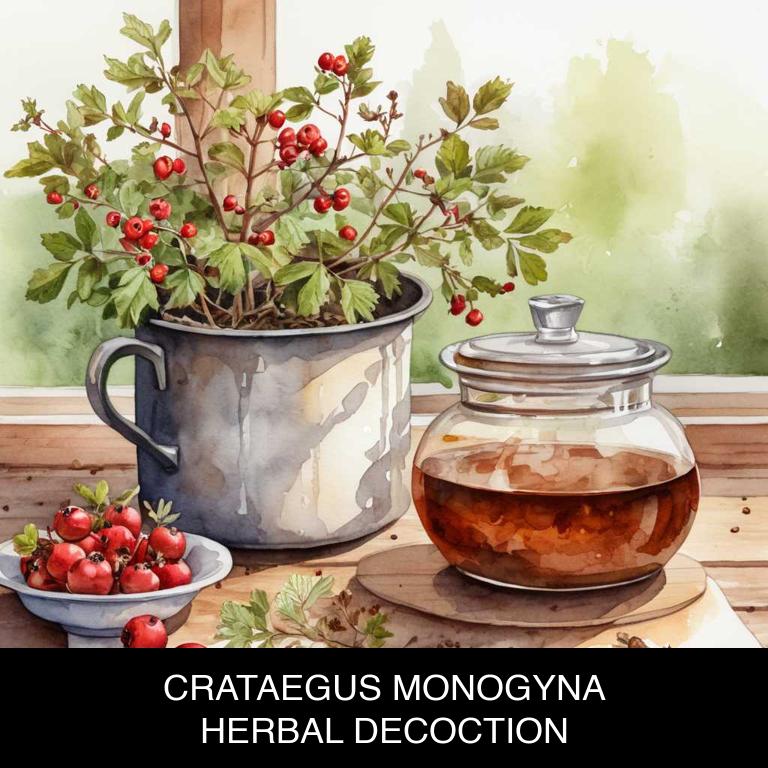
Medicinal Constituents
The list below shows the primary medicinal constituents in Crataegus monogyna decoctions that help with gallstones.
- Quercetin: A flavonoid with anti-inflammatory properties that may help reduce inflammation in the gallbladder, potentially alleviating gallstone symptoms.
- Epicatechin: A flavan-3-ol with antioxidant properties that may help prevent oxidative stress and inflammation in the gallbladder, reducing the risk of gallstone formation.
- Flavonoids: These polyphenolic compounds may help improve gallbladder motility, reducing the risk of gallstone formation by promoting the regular emptying of bile from the gallbladder.
Parts Used
The list below shows the primary parts of hawthorn used to make decoctions for gallstones.
- Leaves: They are used due to their high content of flavonoids and phenolic acids, which have antioxidant and anti-inflammatory properties.
- Fruits: They are used because they are rich in flavonoids and phenolic acids, which may help to reduce inflammation and prevent the formation of gallstones.
- Buds: They are used due to their high antioxidant and anti-inflammatory properties, which may help to protect the liver and prevent gallstone formation.
Quick Recipe
The following recipe gives a procedure to make a basic hawthorn for gallstones.
- Harvest 20g of fresh leaves and 50g of fresh berries of the plant under full moon conditions.
- Dry the combined plant material at 40 degrees celsius for 24 hours to preserve its properties.
- Crush 10g of dried plant material into a fine powder using a mortar and pestle.
- Steep 5g of the powder in 250ml of boiling water for 10 minutes to release its active compounds.
- Strain the liquid and discard the solids to obtain the herbal decoction.
10. Salvia officinalis
Sage decoctions helps with gallstones because it has natural anti-inflammatory properties that reduce inflammation in the bile ducts, allowing for smoother digestion and reduced risk of stone formation.
Additionally, sage's antioxidant compounds help to neutralize oxidative stress in the liver, which can contribute to the development of gallstones.
The gentle, soothing action of sage decoctions also helps to stimulate the gallbladder's natural contractions, encouraging it to release stored bile and reduce the likelihood of stones forming.
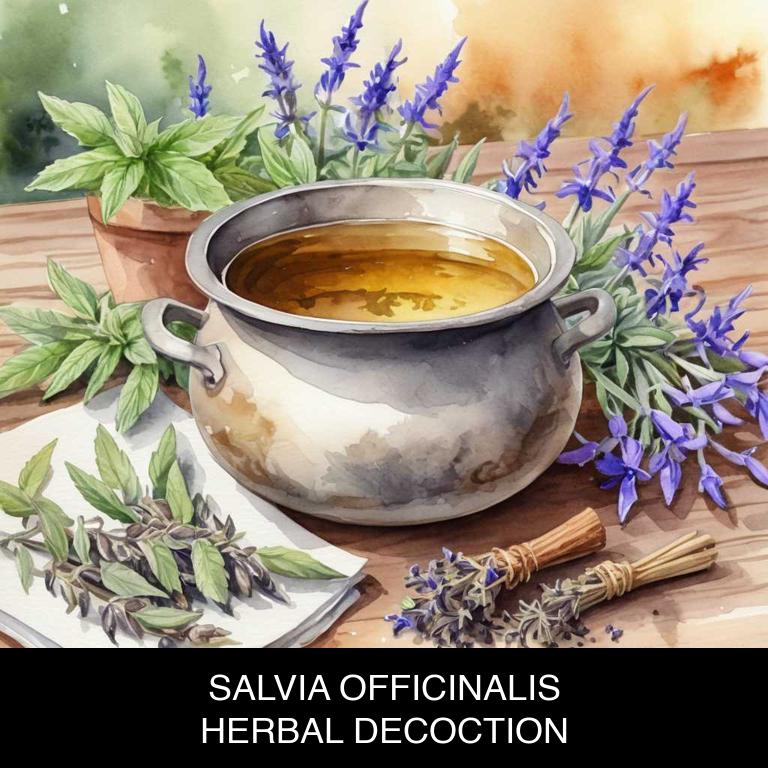
Medicinal Constituents
The list below shows the primary medicinal constituents in Salvia officinalis decoctions that help with gallstones.
- Rosmarinic acid: This phenolic compound has antioxidant and anti-inflammatory properties, which may help reduce oxidative stress and inflammation in the gallbladder, potentially alleviating gallstone formation.
- Ursolic acid: This triterpenoid has been shown to have hepatoprotective and anti-inflammatory effects, which may help protect the gallbladder from oxidative damage and inflammation, thereby reducing the risk of gallstone formation.
- Salvianolic acid a: This phenolic compound has antioxidant and anti-inflammatory properties, which may help reduce oxidative stress and inflammation in the gallbladder, potentially alleviating gallstone formation.
Parts Used
The list below shows the primary parts of sage used to make decoctions for gallstones.
- Leaves: They are the most commonly used part due to their high concentration of essential oils, which are believed to have medicinal properties.
- Roots: They are also used, as they contain saponins and other compounds that may help in treating gallstones.
- Stems: Stems are sometimes used for decoctions, particularly for their potential antioxidant and anti-inflammatory properties.
Quick Recipe
The following recipe gives a procedure to make a basic sage for gallstones.
- Harvest 25g of fresh salvia officinalis leaves or 5g of dried leaves for decoction preparation.
- Rinse the harvested leaves with cool water to remove any dirt or debris thoroughly.
- Combine the harvested leaves with 250ml of boiling water in a heat-resistant glass container.
- Steep the mixture for 5-10 minutes to allow the active compounds to infuse into the water.
- Strain the decoction through a cheesecloth or a fine-mesh sieve into a clean container.
What is the best combination of herbal decoctions to use for gallstones?
The best combination of herbal decoctions that help with gallstones is a blend of Dandelion root (Taraxacum officinale), Milk Thistle seeds (Silybum marianum), and Turmeric root (Curcuma longa).
Dandelion root helps to stimulate the liver and gallbladder, while Milk Thistle seeds support liver health and aid in the dissolution of gallstones. Turmeric root, rich in curcumin, reduces inflammation and promotes healing.
This trio can be decocted together to create a soothing, restorative tea that supports the body's natural healing processes and alleviates gallstone symptoms.
What ailments similar to gallstones are treated with herbal decoctions?
Ailments similar to gallstones/decoctions.html">gallstones/decoctions.html">gallstones that are treated with herbal decoctions are kidney stones, bladder stones, and liver flukes.
Herbal remedies like dandelion root, uva ursi leaves, and black cohosh roots have been traditionally used to treat these conditions due to their anti-inflammatory and diuretic properties.
These herbs help to reduce pain and inflammation associated with these ailments, making it easier for the body to eliminate stones or parasites naturally.